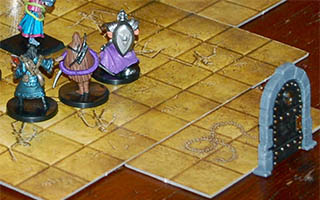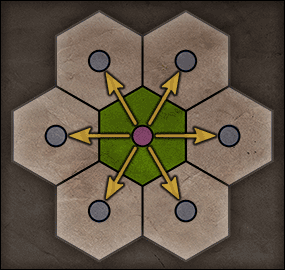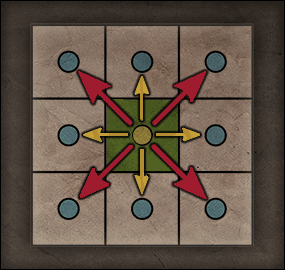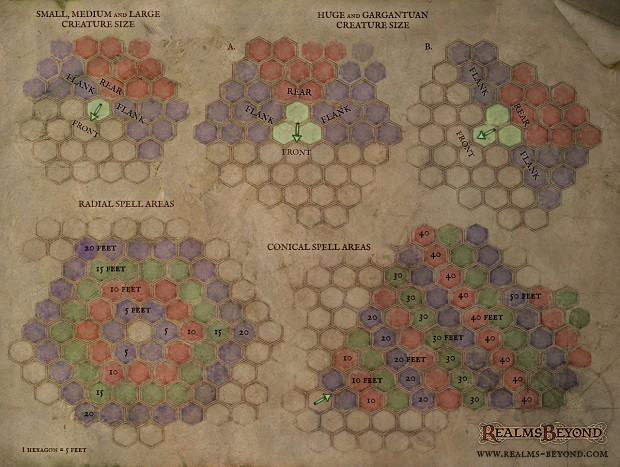As you may recall, we touched upon this particular subject some time ago very briefly when we talked about our die rolling experiments with D&D 4th Edition: Six sides are better than four. Let’s elaborate.

This particular subject led to some of the most heated discussions among ourselves while we designed the combat system for Realms Beyond. There are times in the development cycle of a game that can lead to actual combat. Only in those cases, it typically gets resolved with arguments and words rather than the use of force and weapons.
Players of traditional D&D campaigns and those of the SSI Goldbox Games used to prefer dungeons and battlefields that were based on a square grid. Wargames and virtually every turn-based strategy game, on the other hand, favor hexagons. Modern D&D computer games, such as the Temple Of Elemental Evil, often abandoned a (visible) grid altogether, leaving game designers with three different approaches, each with its own crucial implications in regards to combat, level design, and spell handling.
After many lengthy exchanges discussing various arguments, in the end, we decided to settle upon a hexagonal grid. Perhaps the strongest argument for hexes was that they add more depth to combat. As I said before, six sides are just better than four. But there's more to it. Here are three additional reasons that serve as viable arguments for hexes and against squares (or no grid at all).
Reason One: Movement Cost


Movement costs are more obvious. Unlike squares, where diagonal movement is actually longer and diagonal squares touch each other only in a single point, hex positions always share entire sides and crossing from one field into an adjacent one is always the same distance. In square grids, the game somehow has to account for the longer diagonal distance. Typically this is done by ignoring it and therefore providing a built-in exploit, as it becomes cheaper to move diagonally, instead of making the two straight moves that would otherwise be necessary to reach the same field. If you ever played D&D 4th Edition, which will allow you to move diagonally at the cost of one square, you will be well aware of the irresistible urge to exploit that apparent “extra ground” you can cover by moving diagonally.
Within a hex grid, you simply do not have that problem. Every move covers the same distance and can, therefore, safely have the same cost. We felt that in a computer game where you want to simply point at your target field and have the character move there by itself, it was not only much easier to calculate the path across a hex grid, but it was also more balanced because no movement points were squandered as a result of some awkward navigation.
Reason Two: Correct Facing
With hex fields, you can make sure characters are always properly facing in the direction of their movement. With squares, you either have to start implying that the field your standing on is actually an octagon. You have eight directions that your character could face in, or you make facing irrelevant altogether, the way D&D 4th Edition did, where it is only relevant that two enemies cover opposing squares adjacent to one another. In Realms Beyond, we wanted facing to be relevant. We have actions like backstabbing where it is important because trying to get into another character's back or trying to make sure the back of your own character is covered, adds immensely more depth to the decisions that need to be made during combat.
Reason Three: Organic Feel
Outside of combat, we have a world that is supposed to look natural or even organic. To achieve this as best as possible, we do not limit our level designers to build their levels based on a fixed grid, especially as the grid is truly only relevant during combat and combat makes up only one part of the game as a whole. Most areas of a level may never even have the grid enabled because no combat encounter will ever occur there. When we ran a number of tests, it also turned out that hex grids were much better suited to represent natural-looking scenes. By comparison, if we were to use square grids, we would have to readjust entire scenes to make sure they align with the square grid. While this is fine for buildings with straight walls and rectangular corners, for a path through the woods with rocks splattered across and fallen trees partially covering the ground, it would have had a severe visual impact.
Having considered all these factors, the decision turned into a no-brainer, really, so why the heated discussions I mentioned before? There's a very simple reason for that. For pen & paper games, it’s a whole lot easier to prepare a map on a square grid, at least unless you have some experience working with hexes. Since we prototyped much of our combat system on paper, some of us were simply reluctant to give up the squares at first. Force of habit, I suppose. We had two choices. We decided to settle the argument with a drinking contest and while we were at it, we prototyped a combat scene with a hex grid. It worked out very well. So much so, in fact, that everyone was happy (and felt sick like a dog).

